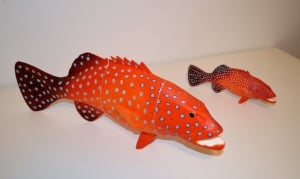For this interesting and important behavioural study, we had to call on two of our core services: 3D Scanning and 3D Printing.
An initial meeting provided us the brief and intent for George. Then we were able to put a plan in place to support his work. George wanted to use 3D models in an experiment investigating the behavioural ecology of predator prey interactions. In this first experiment we needed to closely capture and recreate the fish sufficiently so that that it elicited anti-predator behaviours from prey; this was vital to the success of the project.
This was achieved by 3D Scanning with a powerful handheld Creaform laser scanner and post processing the resulting scanned data with Geomagic software to achieve a watertight stl file. This ensured the high-resolution capture was successfully output in the final 3d printed models.
Both fish models were then split into smaller sections for ease and economy of 3D Printing. Once built the resulting parts then bonded together and sanded along join lines as shown below.


To add greater realism and closer resemblance to the living fish (as explained a vital requirement for a behavioural study) the models were then painted accordingly, as shown below, ready for testing.


We look forward to seeing the findings of the study and while we await, we continue to plan for the next study where George is looking to add greater realism by working with a caught shark from local waters.
If you have a requirement for 3D Scanning, 3D Printing or a range of CAD and digital processes in your project please contact us with your requirements. We are happy to support academics in their work as well as commercial projects using these processes.
